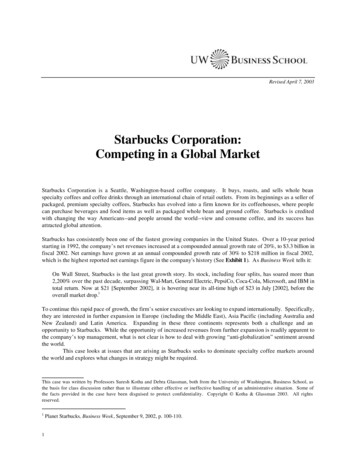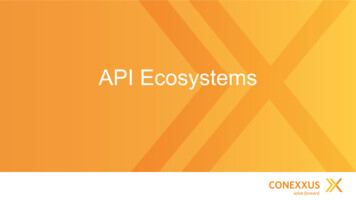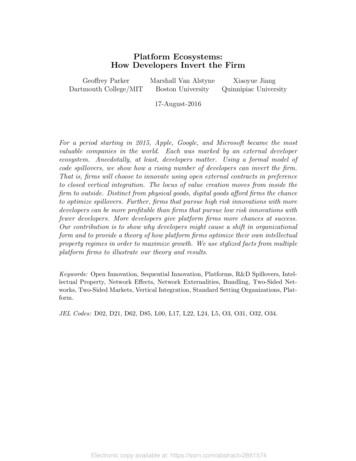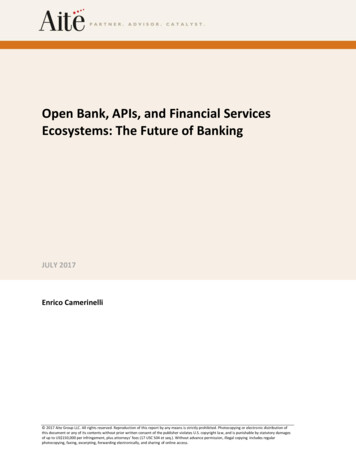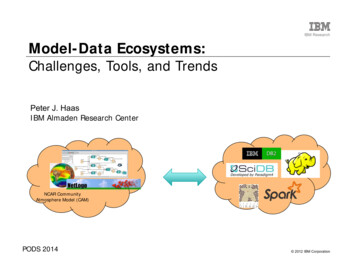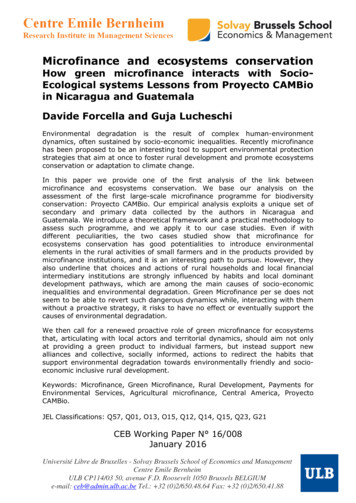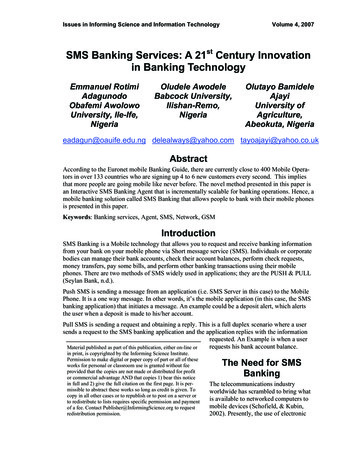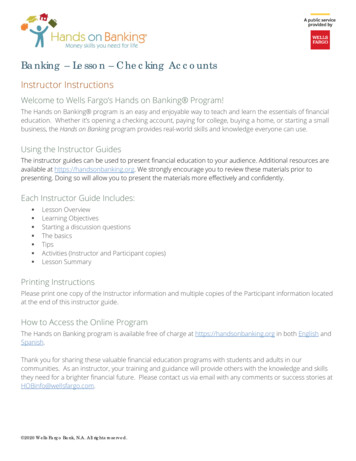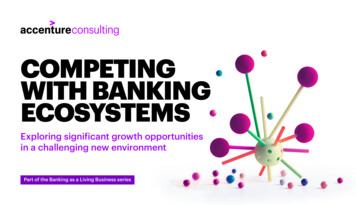
Transcription
COMPETINGWITH BANKINGECOSYSTEMSExploring significant growth opportunitiesin a challenging new environmentPart of the Banking as a Living Business series
TABLE OF CONTENTS1A NEW RELATIONSHIP MODELIN AN ERA OF OPEN BANKING 044FINDING THE RIGHT OPERATING MODEL 14Develop separate partnership models with tactical and strategic partners 17Effectively manage and monitor performance 18Equip the ecosystem with intelligent marketing capabilities 202DEFINING BANKINGECOSYSTEMS 073CREATING VALUE THROUGHBANKING ECOSYSTEMS 112COMPETING WITH BANKING ECOSYSTEMSSet up an agile ecosystem management organization 21Move towards an API-enabled architecture 22Take ownership of ecosystem security 235CONCLUSION 24
EXECUTIVE SUMMARYBanks facing slower growthare on the lookout fora new relationship model.The new imperatives forbanks include rebuildingtrust in the era of OpenBanking and transformingcustomer interactionsinto hyper-relevant,personalized experiences.3COMPETING WITH BANKING ECOSYSTEMSOur survey of 120 global banks shows thatnine out of 10 banks are strongly interestedin customer-facing ecosystems, with banksparticipating in a network of interlinkedcompanies, working together to deliver valuepropositions to meet customers’ core needs.Banking leaders (at the Chief Digital Officer(CDO), Chief Marketing Officer (CMO) andChief Strategy Officer (CSO) levels) havemultiple options in developing and launchingsuch ecosystems – as marketplace orchestrators,third party ecosystem participants, openbanking platforms or referral platforms –with all paths leading to increasing revenues,reducing customer churn and/or expandingcustomer engagement.The key to success for banks consideringcustomer-facing ecosystems is in finding theright operating model. Before launch, banksshould develop a clear strategy as to whichcustomer segments to focus on and how valueis to be delivered, as new capabilities areneeded to support the ecosystem operatingmodel. They should be aware of considerationsrelated to three core domains: ecosystem partners,business architecture and technology. Banks thatget these matters right will be well-positionedto attract and retain customers based on value,immediacy and, above all, trust.As we have explored elsewhere in our Bankingas a Living Business series, trust is central tostrong banking relationships and is built throughpersonalization, consistent service delivery,security of data and assets, and the ability tosupport customers at key moments in their lives.
14COMPETING WITH BANKING ECOSYSTEMSA NEW RELATIONSHIPMODEL IN AN ERAOF OPEN BANKING
With more than 327 billion paid in fines by the20 largest global banks for mis-selling financialproducts since 2012,1 the agenda for banks is clear:finding a new relationship model to rebuild trustif they want to secure sustainable growth.After looking at a number of digital platforms,some banks have identified customer-facingecosystems as one possible model to rebuildtrust, seeking to multiply customer interactionsand transforming such interactions intohyper-relevant, personalized experiences.As seen in Figure 1, Accenture research findsthat 88 percent of banks surveyed believethat ecosystems will be an important way ofinteracting with customers in the future, while89 percent see customer-facing ecosystemsas the main driver of future value creationin the banking industry.2Figure 1 – Bank Executive Ecosystem Sentiment“Ecosystems will change the bankcustomer relationship in the future”Agree Strongly AgreeGLOBALCOMPETING WITH BANKING ECOSYSTEMS88%NORTHAMERICA89%97%EUROPE86%ASIA PACIFIC86%Source: 2019 Accenture Banking Ecosystems Survey5“Ecosystems-related initiatives will bethe main driver of future value creationin the banking industry”Agree Strongly Agree87%88%93%
In some places, consumers are alreadyexperiencing different types of bankingecosystems. The Spanish bank BBVA hasdeveloped multiple ecosystems, such as Valora,which helps customers to understand theproperty market in different areas to facilitatedecision-making in relation to purchasing orrenting a new home.3 Moreover, through Valora,users can control expenses, plan for renovationsand appliances renewal and access mortgageand insurance information.In Singapore, DBS offers a one-stop onlinemarket for customers looking to purchaseor sell cars through its Car Marketplace.4Through the marketplace, users have accessto a budget calculator to estimate the loanamount, they can search for cars based ontheir budget, and they can arrange a test driveonline. Once the car is purchased, customerscan benefit from additional services like savingson petrol and insurance. But DBS’s ecosystemefforts are not limited to the mobility space—they are also targeting other life momentsthrough marketplaces in the utilities, housingand travel spaces.56COMPETING WITH BANKING ECOSYSTEMSIn the US, USAA has developed multipleecosystems too. For example, it offerscustomers an extensive housing ecosystemthrough its Residential Real Estate Services.6Through the network, customers can benefitfrom discounts when using a pre-approvedreal estate agent, as well as search for propertylistings, screen tenants, protect their homesand get discounts on things like home security,moving services and contractor services.Banks that offer these integrated, contextualizedexperiences go beyond traditional financialneeds and meet broader customer needs.They support their customers, not just ingetting financing to buy a house, but in thewhole journey to move in, becoming hyperrelevant in their customer’s everyday life.Combining financial and non-financial servicesthrough ecosystems becomes an opportunityto establish (or re-establish) trust.The customer-facing ecosystem is an excitingfrontier for banks. To help explore this frontier,we begin by defining the banking ecosystemand how banks can create value throughsuch ecosystems.
27COMPETING WITH BANKING ECOSYSTEMSDEFINING BANKINGECOSYSTEMS
Digital PartnerFigure 2 – Customer-facing Ecosystem Plays Available to Banks3RD PARTY ECOSYSTEM PARTICIPANTREFERRAL PLATFORMOPEN BANKING PLATFORMChannelsWe look at customerfacing ecosystems asa network of interlinkedcompanies, workingtogether to delivervalue propositionsto end customers.Banking ecosystems often operateacross traditional industry boundaries,with different players working in thesame space to deliver to bankingcustomers services they need and value.BankLIFE MOMENTS ORCHESTRATORTRADITIONAL BANKINGMARKETPLACES ORCHESTRATORBankAs Figure 2 illustrates, banks haveseveral different options in developingand launching ecosystems.ProductsSource: Accenture Research8COMPETING WITH BANKING ECOSYSTEMSDigital Partner
We have identified five specific modelsfor banks, which are:LIFE MOMENTS ORCHESTRATORBanks can orchestrate their own ecosystem orecosystems built around specific life moments(such as buying a house or a car or becominga parent), offering partners access to their owncustomer base in exchange for fees. Americanbank Capital One, for example, offers itsAutoNavigator platform where customers canpre-qualify for lending, explore dealers andfind a car to purchase.7 Similarly, Chase allowsits customers to buy a car directly from itswebsite, leveraging a partnership with Truecar.8MARKETPLACE ORCHESTRATORStill applying a life needs lens, banks can operateas marketplace orchestrators through whitelabelling or co-branding, selling non-financialproducts (such as home appliances, travel, ormobile phones) to their customers. For example,Singapore’s OCBC provides a marketplace forparents that serves as a one-stop portal offeringeveryday essentials, nursing and feedingproducts, medical services and, of course,the ability to open a bank account for the child.99COMPETING WITH BANKING ECOSYSTEMSMoreover, OCBC operates a digitalhome buying platform whereby customers,for example, can search for propertiesand get valuations, insurance and houserenovation design ideas.10THIRD-PARTY ECOSYSTEM PARTICIPANTBanks can join third-party platforms to offer theirown banking products to third-party customers.In Australia, ANZ has done this by partnering withHoncho,11 an online platform that offers users theopportunity to set up their small business in oneday, as well as tools to help their business grow.Customers that apply to open an ANZ businessaccount through Honcho get a waiver on theirmonthly account service fee. Another example:Silicon Valley Bank provides USD bank accountsto start-ups directly on Stripe’s website.12OPEN BANKING PLATFORMBanks can allow partners to incorporateproducts, data and or specific processes in theirvalue propositions, leveraging open applicationprogramming interfaces (APIs). Spanish bankBBVA has, for example, launched an API Marketallowing third parties to integrate the bank’sproducts and services into their own platforms.13REFERRAL PLATFORMIn this model, the bank does not originateon third party platforms but directs rejectedcustomers to other providers, such as a largebank sending a small business to a designatedonline finance platform. In the UK, for example,when banks such as HSBC, Barclays, Lloydsand Santander reject financing for a smallbusiness, since 2016, they offer the businessa referral to a designated online credit brokersuch as Alternative Business Financing,Funding Options or Funding Exchange.14In addition to choosing their preferredecosystem model, banks have a wide arrayof options when it comes to which areasto focus on. Typically, banks choose to focuson a handful of different areas. As illustratedin Figure 3, the most popular areas are theones close to banks’ core revenue sourcesin areas such as business services, housingand wealth management.
Figure 3 - Which of the following areas are you targeting with your ecosystem strategy? (Top three summary)ExamplesServices58% 38% 38% 36% 28% 25% 21%BUSINESS SERVICESHOUSINGWEALTHBusiness account,Lawyer services,Website creation,Online businesspromotion andmarketing platform,Accounting services,E-invoicing andpayment services,Reporting toauthoritiesMortgage,House-huntingservices, Homemaintenance checksand discounts,Affordabilityassessment, Homesecurity services,Storage services,Tenant screening,Utility providerswitch facilitationBudgeting,Internationalmoney transfer,Energy billcomparisonand utilityprovider switchBe Business Readyby Honcho poweredby ANZ, RBC LabsWave, SberbankBusiness OnlineUSAA HomeSolutions,DBS PropertyMarketplace,BBVA Valora, OCBCHome One AdvisorYolt (ING),First Direct Artha,Commonbond xCitiBankPUBLIC SERVICESRETAILMOBILITYPay fines, Checkcredit history, Taxservices, CompanyregistrationConsumer finance,Ecommerce platformwith exclusive offers,discounts andcashback, E-gift cardsCar, Financing,Insurance, Ongoingmaintenance, PetroldiscountsInsurance,Incentive-basedsavings rate,Medical checks,Insurance, Spa,gym, sportsweardiscounts,Online doctorappointmentsRBC Labs Arrive,Emirates NBDSkyshopper, TinkoffState ServicesEmirates NBDSkyshopper,MacquarieMarketplace,BBVA de Compras,Goodie by BankMilleniumDBS CarMarketplace,Capital One AutoNavigator, ChaseCar Buying Serviceby TRUECarEmirates NBDLive Well, EmiratesNBD FitnessAccount, VitalitySource: 2019 Accenture Banking Ecosystems SurveyNote: Inclusion in the list of example does not imply that the bank was part of the survey interview process.Examples drawn from organizations’ websites and annual reports10COMPETING WITH BANKING ECOSYSTEMSHEALTH
311COMPETING WITH BANKING ECOSYSTEMSCREATING VALUETHROUGH BANKINGECOSYSTEMS
Typically, there are three ways that bankingecosystems create value: Expanding primary relationships.By offering hyper-relevant experiencesthrough ecosystems, banks can increase thevalue of an extended relationship with otherfinancial products, increasing cross-selling(such as adding a consumer loan for homeappliances to mortgage holders). Nearly allbanks we surveyed are seeking to expand thescope of primary banking relationships overthe next three years through cross-selling.15 Generating new revenues streams.Banks can offer ecosystem partners accessto their customer base and data in exchangefor fees, by orchestrating an ecosystem orby opening their infrastructure. Our researchindicates that, over the next three years, mostbanks expect more than 10 percent of theirincremental revenues to be generated byecosystem plays.16 Reducing customer churn.By orchestrating or joining third partyecosystems, banks can deliver moremeaningful customer experiences and canfollow customers beyond the boundariesof their traditional relationships. Banks wesurveyed expect ecosystem initiatives to helpreduce the churn rate by up to 10 percentover the next three years.17Despite increased globalization andinterconnectivity, banking markets remaininherently local. This means that differentregions vary significantly in terms of adoptingbanking ecosystems. Banks in the Asia-Pacificregion are more likely (at 82 percent) to considerecosystems a top priority than European banks(63 percent), with North American banksin the middle at 74 percent.18 We see this asan indication that there is considerable roomfor European banks to grow in this area andtake advantage of the opportunities presentedto first movers.Several factors drive the push for ecosystems,affecting the readiness of different regionsto adopt ecosystems. These include:12COMPETING WITH BANKING ECOSYSTEMS Customers. Digital attitudes amongcustomers affect demand for integratedpropositions. Accenture research shows thatAsia Pacific has the highest share of “Pioneers”or consumers that are tech-savvy and hungryfor innovation in services and channels.19 NorthAmerica and Europe, in contrast, account forthe largest share of “Traditionalists”, consumersthat lack confidence in technology and areuninterested in new products and/or services.Since 80 percent of Pioneers are interestedin integrated propositions—compared to just20 percent of Traditionalists—the customer pushfor ecosystem plays is str
strong banking relationships and is built through personalization, consistent service delivery, security of data and assets, and the ability to support customers at key moments in their lives. 3 COMPETING WITH BANKING ECOSYSTEMS. 1 A NEW RELATIONSHIP MODEL IN AN ERA OF OPEN BANKING 4 COMPETING WITH BANKING ECOSYSTEMS. With more than 327 billion paid in fines by the 20

